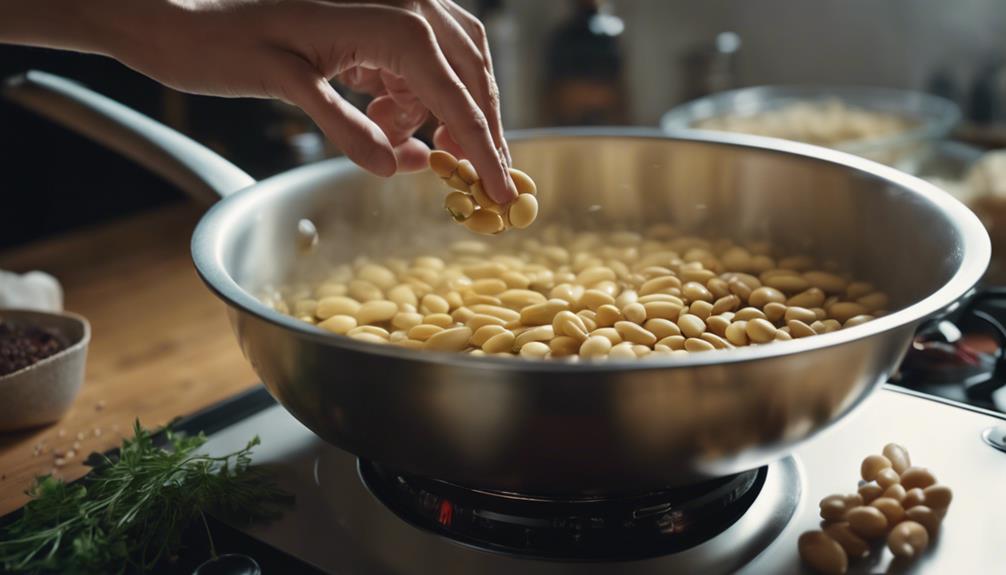Choosing the right butter is key for managing diabetes. Opt for grass-fed butter, which has additional nutrients and healthy fats. Unsalted butter is also a good choice, as it helps keep sodium intake in check. Consider butter alternatives like olive oil or avocado spreads, which are rich in unsaturated fats. Always use butter in moderation and pair it with high-fiber, protein-rich foods to help stabilize blood sugar levels. If you're curious about making even better choices for your diet, you've got more options to explore.
Key Takeaways
- Grass-fed butter offers higher nutrient content and is suitable for many lactose intolerant individuals.
- Olive oil spreads and avocado-based spreads are healthier alternatives to regular butter.
- Use unsalted butter to help manage sodium intake and blood pressure levels.
- Pair butter with high-fiber and protein-rich foods to moderate blood sugar impact.
- Keep saturated fat intake below 10% of total daily calories for better heart health.
Nutritional Profile of Butter
Butter's nutritional profile reveals it's a calorie-dense food with significant amounts of fat and essential nutrients. Each tablespoon of unsalted butter contains 102 calories and 11.5 grams of fat, making it a rich energy source.
Despite its high-fat content, butter provides you with essential nutrients like choline, calcium, phosphorus, and potassium. These nutrients play pivotal roles in your body, from supporting brain function to maintaining bone health.
Additionally, if you opt for grass-fed butter, you might benefit from a higher nutrient content. Grass-fed butter is known to contain more short- and medium-chained fatty acids, which have various health benefits. These fatty acids can be easier for your body to digest and may support better metabolic health.
For those concerned about dairy sensitivities, butter's negligible lactose content post-processing makes it suitable for many individuals, even if you're lactose intolerant. This means you can enjoy the creamy richness of butter without worrying about digestive discomfort.
Butter and Diabetes
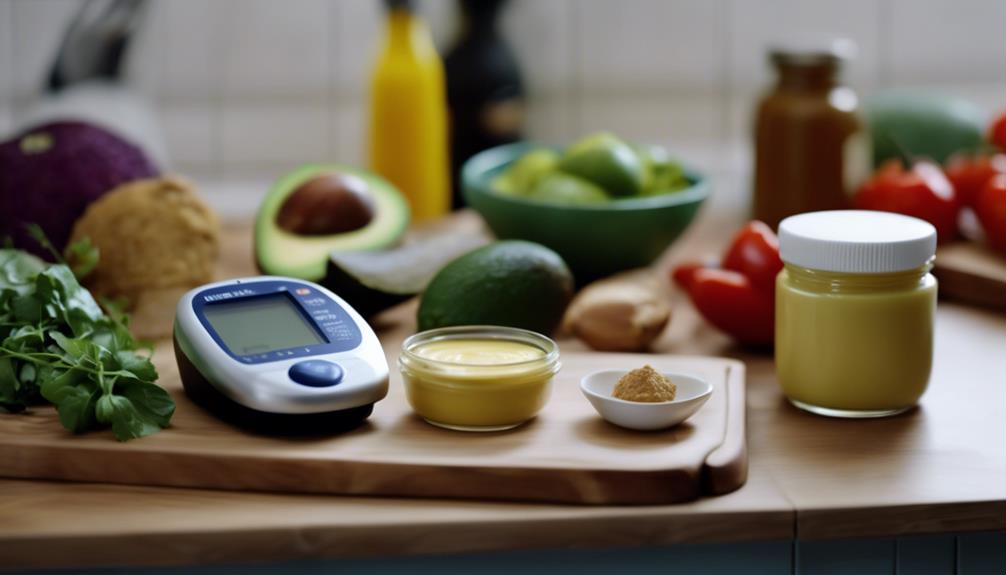
When considering butter in your diet as a diabetic, it's important to understand its impact on blood sugar and explore healthier alternatives.
Butter's high saturated fat content can affect insulin resistance, making it less ideal for regular consumption.
Instead, opt for spreads with unsaturated fats to better manage your condition.
Impact on Blood Sugar
Consuming butter can impact your blood sugar levels due to its high saturated fat content. When you have diabetes, keeping a close eye on your butter consumption is critical for managing blood sugar levels. Butter's saturated fat can influence your body's ability to use insulin efficiently, potentially leading to higher blood sugar levels. Monitoring portion sizes is essential.
Pairing butter with high-fiber foods can help mitigate these effects. Foods rich in fiber slow down digestion and the absorption of sugar, helping to prevent spikes in blood sugar levels. Similarly, combining butter with protein-rich foods can aid in better blood sugar control. Protein helps stabilize blood sugar by slowing down carbohydrate absorption, providing a more balanced energy release.
Opting for grass-fed butter can offer additional nutrients that may benefit you. Grass-fed butter typically contains higher levels of omega-3 fatty acids and vitamins like K2, which can support overall health. However, it's still important to be mindful of how much butter you consume and to balance it with other healthy food choices. By doing so, you'll be better equipped to manage your diabetes and maintain stable blood sugar levels.
Healthier Butter Alternatives
For diabetics seeking healthier alternatives to butter, consider using spreads made from olive oil, canola oil, avocado, or nut butters. These options provide healthy fats that are beneficial for your overall health and diabetes management. Unlike traditional butter, these alternatives can help improve your cholesterol levels and support a heart-essential diabetes diet.
When comparing Butter Vs. healthier options, it's clear that these alternatives offer better choices for diabetic individuals:
- Olive Oil Spreads: Rich in monounsaturated fats, they help reduce inflammation and improve heart health.
- Avocado-Based Spreads: Packed with fiber and healthy fats, they can help stabilize blood sugar levels.
- Nut Butters: Such as almond or peanut butter, these spreads provide protein and healthy fats, making them a nutritious option.
Moderation is key when diabetics consume butter or any of its alternatives. While diabetes and butter can coexist in your diet, it's vital to keep your saturated fat intake below 10% of your total daily calories.
Healthier Butter Options
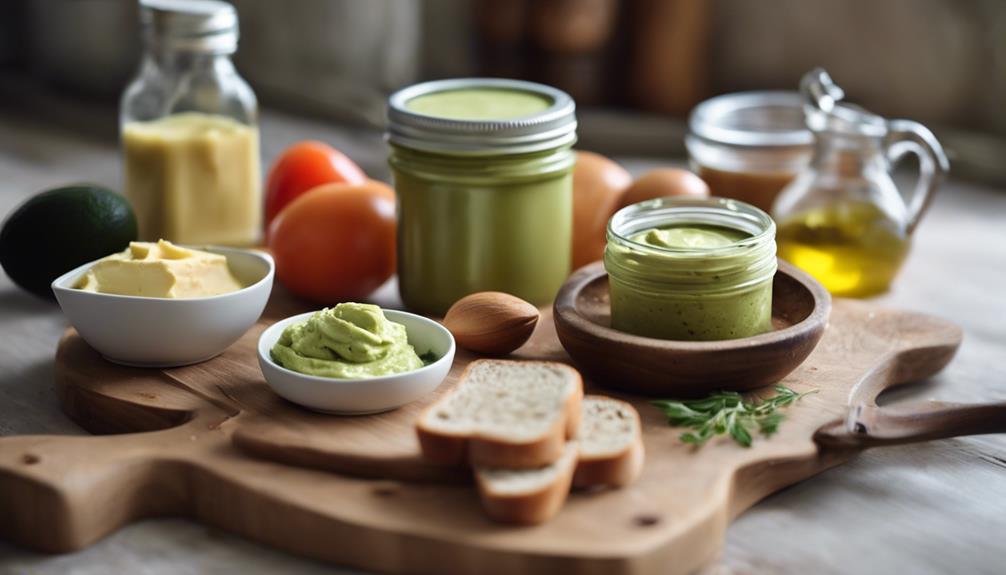
Grass-fed butter and unsalted varieties can be healthier choices for diabetics looking to manage their condition. Grass-fed butter often contains higher levels of beneficial nutrients compared to conventional butter. It also has a more favorable ratio of unsaturated fats to saturated fats.
Choosing unsalted butter helps you keep your sodium intake in check, which is essential for managing blood pressure.
If you're looking for butter substitutes, consider options rich in unsaturated fats. Canola oil and spreads made with olive oil are excellent alternatives. These options generally contain more unsaturated fats, which are better for heart health.
Avocado is another great choice, offering healthy fats that can improve your lipid profile. Nut butters, like almond or peanut butter, provide a tasty alternative and are packed with protein and healthy fats.
Managing Butter Intake

To manage your butter intake effectively, focus on portion control and explore healthier alternatives. Opt for spreads made with olive oil or avocado, and consider using nut butters or Greek yogurt as substitutes.
Always remember to pair any butter you use with high-fiber or protein-rich foods to help maintain stable blood sugar levels.
Portion Control Tips
Monitoring your butter intake is necessary for managing diabetes effectively. Portion control is vital in keeping your saturated fat intake within recommended limits, aiding in better diabetes management.
A tablespoon of butter contains around 7 grams of saturated fat, which can impact insulin resistance and contribute to heart disease. For a 2,000-calorie diet, you should aim to consume less than 20 grams of saturated fat per day, including what's in your butter.
To manage your butter intake better, consider these tips:
- Measure your portions: Use a measuring spoon to make sure you're not exceeding the recommended amount.
- Opt for nutrient-dense choices: Grass-fed butter offers higher nutrient content, but moderation is still important.
- Incorporate butter substitutes: Healthy alternatives like canola oil, spreads with olive oil, avocado, or nut butters can help keep your daily caloric and saturated fat intake in check.
Healthier Butter Alternatives
Choosing healthier butter alternatives can greatly improve your diabetes management and overall health. Opting for unsalted butter helps reduce sodium intake, which is beneficial for managing blood pressure. Healthier spreads, such as those made with olive oil or canola oil, contain more unsaturated fats and less saturated fats, making them a better option for your heart and diabetes management.
Grass-fed butter can be a better choice than regular butter because it offers a higher nutrient content, including omega-3 fatty acids and antioxidants. However, it's still important to monitor your saturated fat intake. For a 2,000-calorie diet, aim to consume less than 20 grams of saturated fat per day.
Incorporating alternatives like avocado, nut butters, and Greek yogurt can also be beneficial. Avocado provides healthy fats and fiber, while nut butters offer a good source of protein and healthy fats. Greek yogurt can be used as a spread or in cooking, providing protein and probiotics without the high saturated fat content.
Butter Substitutes

When you're looking for healthier butter substitutes as a diabetic, options like olive oil, avocado, nut butters, and Greek yogurt can make a significant difference in your diet. These choices provide more unsaturated fats, which are better for your heart health compared to the saturated fats found in traditional butter.
Plant-based fats, such as those from avocado, nuts, and seeds, offer diabetic-friendly alternatives that can enhance both the flavor and nutritional value of your meals. Additionally, coconut oil, applesauce, yogurt, and silken tofu are versatile substitutes for butter in cooking and baking, allowing you to maintain the texture and taste you love without compromising your health.
Here's a quick rundown of some excellent butter substitutes:
- Olive oil: Rich in unsaturated fats, promotes heart health.
- Avocado: Creamy texture, loaded with plant-based fats.
- Greek yogurt: Adds tanginess and can be used in both savory and sweet dishes.
Don't forget, grass-fed butter is another option that may have a higher nutrient content compared to regular butter, making it a slightly better choice if you're not ready to fully give up on butter.
Butter in Balanced Diet

While exploring butter substitutes is advantageous, you can still enjoy butter in a balanced diabetic diet by using it in moderation. People with diabetes eat better when they focus on a healthy overall diet. Butter can add flavor and essential nutrients, but it's important to manage your intake. Pairing butter with high-fiber and protein-rich foods can help stabilize blood sugar levels.
Moderation is key because butter contains saturated fat, which can increase the risk of heart disease. Limiting your saturated fat intake helps maintain healthy blood levels and reduces this risk. Use butter as a condiment or flavor enhancer rather than a primary ingredient to keep your calorie intake in check.
Opt for unsalted butter to lower your sodium intake, which is especially important for heart health. Remember, portion control is essential. A small amount of butter can go a long way in enhancing the flavor of your meals without compromising your diet.
Consulting with a dietitian can help you create a personalized meal plan that incorporates butter in a healthy and balanced way, ensuring your overall diet supports diabetes management effectively.
Benefits of Unsalted Butter
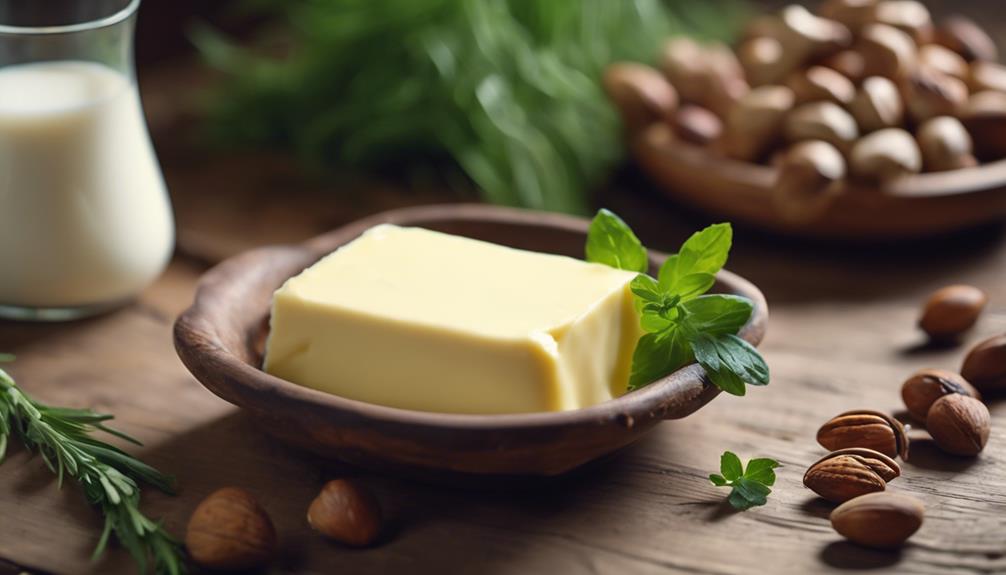
Unsalted butter offers a healthier alternative by giving you control over your sodium intake. For diabetics, managing sodium consumption is important since excess sodium can negatively impact blood pressure levels. With unsalted butter, you're choosing a healthier option that typically contains around 0-2 mg of sodium per tablespoon. This choice helps you avoid unnecessary health risks associated with high sodium intake.
Unsalted butter also enhances the versatility of your recipes. Without the added salt, you can better balance flavors based on your specific dietary needs and preferences. Here's why it's beneficial:
- Sodium Control: Helps you maintain best sodium intake, which is vital for managing blood pressure levels.
- Versatile Flavor: Unsalted butter allows for greater flexibility in seasoning your dishes.
- Reduced Health Risks: Lower sodium levels mean fewer complications like high blood pressure.
Incorporating unsalted butter in moderation can greatly benefit diabetics. It's a small but impactful change that supports your overall health. You can still enjoy the rich taste of butter without compromising your dietary goals. Remember, moderation is key to maintaining a balanced and healthy diet.
Tips for Using Butter
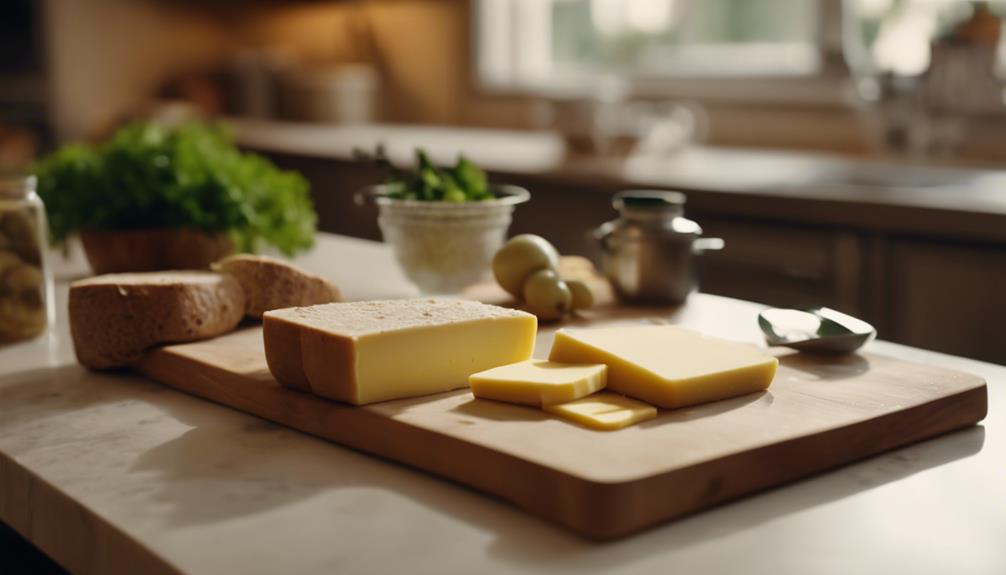
Incorporating butter into your diet can be done thoughtfully and healthily with a few smart tips. Start by using small amounts of butter to add flavor to your dishes. For instance, a little bit on steamed vegetables like broccoli or cauliflower can make a big difference.
Dipping artichokes in a teaspoon of melted butter gives them a delicious twist without overdoing it. When it comes to cooking proteins, consider sautéing mushrooms in a small amount of butter. This can elevate the flavor of chicken or fish, making your meals more enjoyable while keeping butter consumption in check.
For those who enjoy baking, exploring vegan options can be a game-changer. Ingredients like coconut oil or applesauce can replace butter, offering healthier alternatives. Additionally, you can swap out some butter in your baked goods for olive oil or nut butters.
These swaps not only boost the nutritional profile of your treats but also align better with a diabetic-friendly diet.
Frequently Asked Questions
What Type of Butter Should Diabetics Use?
You should use unsalted butter. It helps you control your sodium intake, which is essential for managing blood pressure. High sodium levels are common in people with diabetes, so unsalted butter is a healthier option.
What Is the Best Nut Butter for Type 2 Diabetes?
You should consider almond butter first for type 2 diabetes. It's low in carbs and high in healthy fats and fiber. Peanut butter and sunflower seed butter are also great options due to their beneficial nutrients.
What Spread Can Diabetics Eat?
Did you know that unsaturated fats can reduce heart disease risk by 30%? Opt for spreads like olive oil, avocado, or canola oil. These options help manage your blood sugar levels and support a balanced diet.
Can Diabetics Eat Butter and Cheese?
Yes, you can eat butter and cheese in moderation. Choose low-fat or reduced-fat options and pair them with high-fiber foods. Always consult your healthcare provider or dietitian for personalized advice on your diabetic meal plan.
Conclusion
When it comes to butter and diabetes, balance is key. While standard butter has its pitfalls with high saturated fats, healthier options like unsalted or plant-based butters offer a better alternative.
By managing your intake and opting for these substitutes, you can still enjoy your meals without compromising your health.
It's not about giving up butter entirely, but rather making smarter choices to maintain a balanced diet and keep your diabetes in check.

